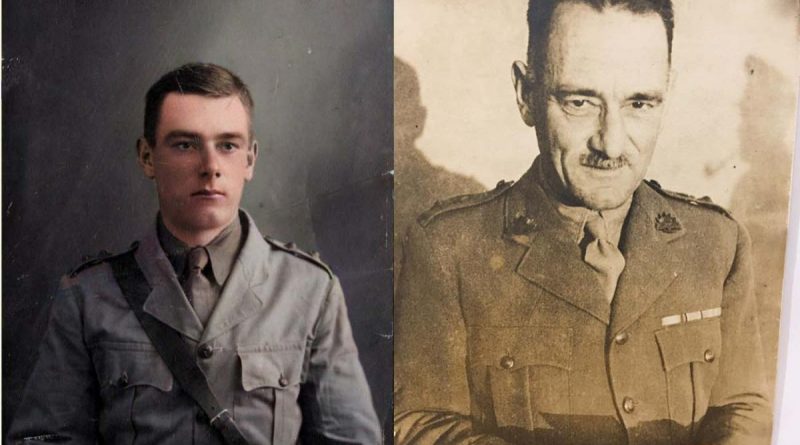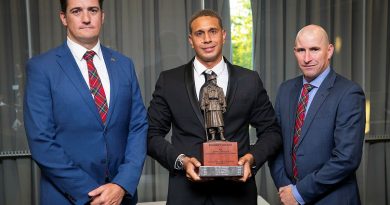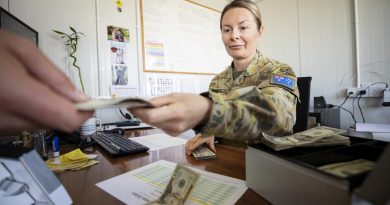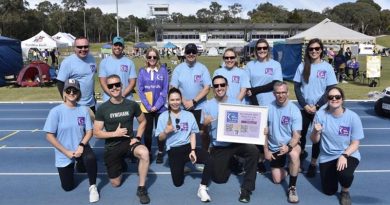Artillery’s venerated gentleman

One of the first ashore at Anzac Cove on the day of the fateful landing was a young Australian artillery subaltern commencing his first wartime mission, with a breathtakingly onerous task to coordinate the deadly naval gunfire to support his fellow Anzacs in their desperate bid to establish a toehold on Gallipoli.
CAPTION: Left, Lieutenant Shirley Goodwin’s enlistment portrait for World War I; and right, Brigadier Shirley Goodwin while deployed in New Guinea during World War II. Story by Captain Joanne Leca.
Any mistake in Lieutenant Shirley Goodwin’s orders, or failure to establish his precarious field telephone link, could spell tragedy or defeat for his comrades.
This year the Royal Regiment of Australian Artillery celebrates its 150th anniversary, a significant milestone for the Army and indeed the nation. From 1871, Australia began an independent artillery capability that continues to this day to be a critical element of the Australian Army and Defence Force.
December 4 also marks the feast day of St Barbara, the patron saint of artillery and gunners.
To mark this significant milestone, the current Head of the Royal Australian Artillery (RAA) and many other artillery officers and personnel gathered at the Australian War Memorial to remember and reflect on the outstanding service, leadership and example set by one of their predecessors, Brigadier Shirley Goodwin, a “gunner” officer serving in both World Wars.
Brigadier Shirley Thomas William Goodwin was born on February 6, 1894 at Ballarat, Victoria.
At the early age of 17, Goodwin enrolled as a staff cadet at the Royal Military College – Duntroon, in the new college’s first intake in 1911. He later commissioned into the Royal Australian Field Artillery in 1914.
From there, he would go on to serve his country in World War I, joining as a Second Lieutenant in the Australian Imperial Forces as a member of the Australian Field Artillery.
Warrant Officer Class 1 (retd) Kevin Browning, who served for 28 years in the Royal Australian Artillery, acknowledged the significance of the artillery anniversary.
“With the Australian artillery celebrating its 150th anniversary this year, it gives us an opportunity to reflect on those who served before,” WO1 Browning said.
“In doing so, we re-discover our heritage and honour their sacrifices, and Goodwin was one of them.”
Since his retirement, WO1 Browning has followed the stories of Goodwin as a volunteer historical researcher with the Royal Australian Artillery Historical Company.
WO1 Browning said people can learn a lot of lessons on leadership, service and self-sacrifice from the past.
“Goodwin was well adored and an outstanding leader. He was known for being a family man, and he took great care of his people,” he said.
A former gunner, Goodwin was selected to represent his country and lead men in the tough and demanding conditions of war, in an astonishing and eventful career that spanned two conflicts across many theatres.
Goodwin was one of the first officers ashore at Anzac Cove.
Associate Professor David Stevens, a former Naval Historian for the Royal Australian Navy, said people can only imagine the prospect of scaling the rugged shore cliffs above Anzac.
“They had to find a vantage point under fire to observe the Turkish positions, establish their locations among the terrain’s bewildering maze of gullies and spurs, and somehow lay a field cable back to the naval signallers who would relay those vital coordinates back to HMS Majestic and the other warships lurking on the horizon,” he said.
Later, Goodwin returned to his Battery, which had tackled the daunting and exhausting task of bringing the guns up the rugged slopes from the beach into firing positions.
Goodwin served with distinction with the 6th and 8th Field Batteries during the Gallipoli campaign until, in another rare opportunity, he was attached to the Royal Navy as an airborne observer in November 1915, providing vital intelligence for the battle planners at Anzac.
However, the campaign was drawing towards its inevitable conclusion, and on December 20, 1915, as the Anzacs evacuated Gallipoli, Goodwin was a crewmember of the last aerial reconnaissance mission to look for potential enemy troop movements when his plane’s engine failed and crashed into the sea.
With the pilot lost at sea, Goodwin was rescued unconscious from the water and revived by a Bavarian medical officer before being handed over to the Turkish forces, a fate unknown to Goodwin’s comrades who were evacuating back to Lemnos.
He was taken as a prisoner to Constantinople (Istanbul) and interned at Afion Kara Hissar in Turkey.
Goodwin was imprisoned for three years, and was repatriated to Egypt at the end of 1918.
On his return to Australia, he went back to the artillery and served initially in Queensland. Then, for three years, he was the Adjutant at the Royal Military College. He was later promoted to Lieutenant Colonel and took command of the Queenscliff coast artillery station.
As Australian forces were plunged into World War II, Goodwin left for the Middle East where he commanded the 2nd/12th Field Regiment of Artillery, including during the battles of Tobruk and El Alamein. While serving in the Middle East, Lieutenant Colonel Goodwin received the Distinguished Service Order. He was promoted to Colonel on his return to Australia.
Prior to leaving for New Guinea, Goodwin was promoted to the rank of Brigadier and commanded the 9th Australian Divisional Artillery during the desperate battles against the tenacious Japanese forces in northern New Guinea.
Tragically, Goodwin was killed at the 9th Divisional Headquarters during one of the last Japanese air raids in New Guinea on October 25, 1943.
Goodwin’s honourable reputation permeated as far as the Commander-in-chief of Allied Forces in the Pacific. General MacArthur’s response on learning of his death was sincere: “He was an exceptionally able officer, who enjoyed the complete confidence of both those who served under him and those who served over him. His death is a severe loss, and will be mourned by Americans equally with Australians.”
Goodwin’s granddaughter Jennifer Craggs recalls the story of events leading up to his death and the impact to those who served under him.
“His men were devastated by his death. He was very fair, and he would do anything for his men,” she said.
“Our family knew that he was a great man, an amazing father and husband.
“Even though I never met him, my grandmother said he would have really loved us.”
Ms Craggs said it was people like her grandfather who placed his people first that would lay the foundations for today’s artillery values. The motto of the RAA is “Where right and glory lead”.
“Quite a few of my family members, including my grandfather, have served in Australian military, of which I’m very proud,” she said.
“My family and I are very honoured that our grandfather is being remembered in this way.”
The touching note to Goodwin’s widow Cynthia from one of the officers serving with Goodwin when he was killed encapsulates his influence and ethos: “It is so difficult to express in words one’s feelings on the death on one who was such a fine soldier and gentleman. He was an inspiration to us all as a leader and a teacher.”
Joining the current and former serving gunners at the Australian War Memorial were several cadets from the Royal Military College about to graduate into the Royal Australian Artillery.
Staff Cadet Toby Exton said the legacy and lessons Brigadier Goodwin left behind were as relevant today as they were decades ago.
“To be part of this commemorative service for a true officer and gentleman like Brigadier Goodwin is a real inspiration for a Duntroon cadet about to embark on the same career path over 100 years later,” he said.
.
.

.
.





